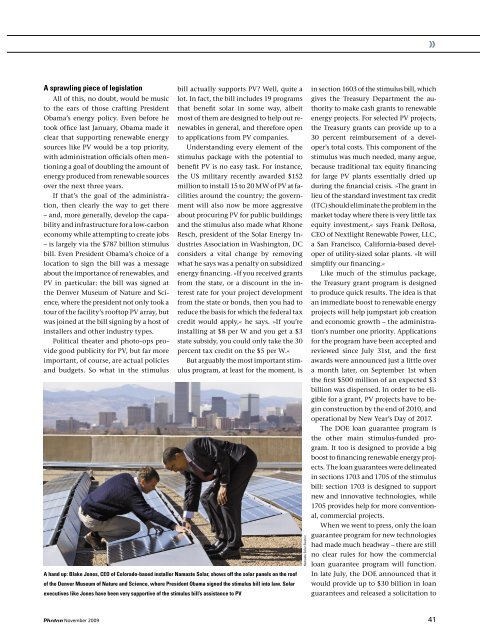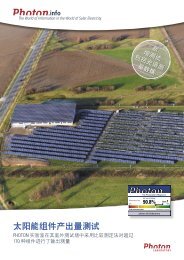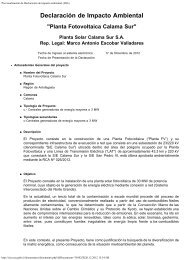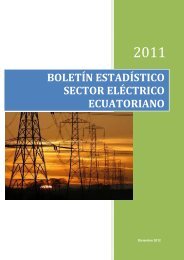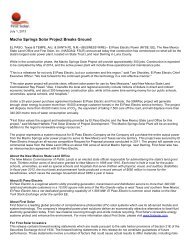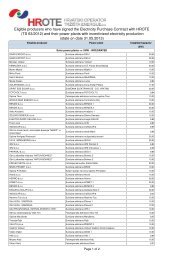INTRODUCTORY SPECIAL INTRODUCTORY ... - PHOTON Info
INTRODUCTORY SPECIAL INTRODUCTORY ... - PHOTON Info
INTRODUCTORY SPECIAL INTRODUCTORY ... - PHOTON Info
You also want an ePaper? Increase the reach of your titles
YUMPU automatically turns print PDFs into web optimized ePapers that Google loves.
A sprawling piece of legislation<br />
All of this, no doubt, would be music<br />
to the ears of those crafting President<br />
Obama’s energy policy. Even before he<br />
took office last January, Obama made it<br />
clear that supporting renewable energy<br />
sources like PV would be a top priority,<br />
with administration officials often men-<br />
tioning a goal of doubling the amount of<br />
energy produced from renewable sources<br />
over the next three years.<br />
If that’s the goal of the administra-<br />
tion, then clearly the way to get there<br />
– and, more generally, develop the capa-<br />
bility and infrastructure for a low-carbon<br />
economy while attempting to create jobs<br />
– is largely via the $787 billion stimulus<br />
bill. Even President Obama’s choice of a<br />
location to sign the bill was a message<br />
about the importance of renewables, and<br />
PV in particular: the bill was signed at<br />
the Denver Museum of Nature and Sci-<br />
ence, where the president not only took a<br />
tour of the facility’s rooftop PV array, but<br />
was joined at the bill signing by a host of<br />
installers and other industry types.<br />
Political theater and photo-ops pro-<br />
vide good publicity for PV, but far more<br />
important, of course, are actual policies<br />
and budgets. So what in the stimulus<br />
bill actually supports PV? Well, quite a<br />
lot. In fact, the bill includes 19 programs<br />
that benefit solar in some way, albeit<br />
most of them are designed to help out re-<br />
newables in general, and therefore open<br />
to applications from PV companies.<br />
Understanding every element of the<br />
stimulus package with the potential to<br />
benefit PV is no easy task. For instance,<br />
the US military recently awarded $152<br />
million to install 15 to 20 MW of PV at fa-<br />
cilities around the country; the govern-<br />
ment will also now be more aggressive<br />
about procuring PV for public buildings;<br />
and the stimulus also made what Rhone<br />
Resch, president of the Solar Energy In-<br />
dustries Association in Washington, DC<br />
considers a vital change by removing<br />
what he says was a penalty on subsidized<br />
energy financing. »If you received grants<br />
from the state, or a discount in the in-<br />
terest rate for your project development<br />
from the state or bonds, then you had to<br />
reduce the basis for which the federal tax<br />
credit would apply,« he says. »If you’re<br />
installing at $8 per W and you get a $3<br />
state subsidy, you could only take the 30<br />
percent tax credit on the $5 per W.«<br />
But arguably the most important stim-<br />
ulus program, at least for the moment, is<br />
A hand up: Blake Jones, CEO of Colorado-based installer Namaste Solar, shows off the solar panels on the roof<br />
of the Denver Museum of Nature and Science, where President Obama signed the stimulus bill into law. Solar<br />
executives like Jones have been very supportive of the stimulus bill’s assistance to PV<br />
November 2009 41<br />
Namaste Solar Electric<br />
»<br />
in section 1603 of the stimulus bill, which<br />
gives the Treasury Department the au-<br />
thority to make cash grants to renewable<br />
energy projects. For selected PV projects,<br />
the Treasury grants can provide up to a<br />
30 percent reimbursement of a devel-<br />
oper’s total costs. This component of the<br />
stimulus was much needed, many argue,<br />
because traditional tax equity financing<br />
for large PV plants essentially dried up<br />
during the financial crisis. »The grant in<br />
lieu of the standard investment tax credit<br />
(ITC) should eliminate the problem in the<br />
market today where there is very little tax<br />
equity investment,« says Frank DeRosa,<br />
CEO of Nextlight Renewable Power, LLC,<br />
a San Francisco, California-based devel-<br />
oper of utility-sized solar plants. »It will<br />
simplify our financing.«<br />
Like much of the stimulus package,<br />
the Treasury grant program is designed<br />
to produce quick results. The idea is that<br />
an immediate boost to renewable energy<br />
projects will help jumpstart job creation<br />
and economic growth – the administra-<br />
tion’s number one priority. Applications<br />
for the program have been accepted and<br />
reviewed since July 31st, and the first<br />
awards were announced just a little over<br />
a month later, on September 1st when<br />
the first $500 million of an expected $3<br />
billion was dispensed. In order to be eli-<br />
gible for a grant, PV projects have to be-<br />
gin construction by the end of 2010, and<br />
operational by New Year’s Day of 2017.<br />
The DOE loan guarantee program is<br />
the other main stimulus-funded pro-<br />
gram. It too is designed to provide a big<br />
boost to financing renewable energy proj-<br />
ects. The loan guarantees were delineated<br />
in sections 1703 and 1705 of the stimulus<br />
bill: section 1703 is designed to support<br />
new and innovative technologies, while<br />
1705 provides help for more convention-<br />
al, commercial projects.<br />
When we went to press, only the loan<br />
guarantee program for new technologies<br />
had made much headway – there are still<br />
no clear rules for how the commercial<br />
loan guarantee program will function.<br />
In late July, the DOE announced that it<br />
would provide up to $30 billion in loan<br />
guarantees and released a solicitation to


